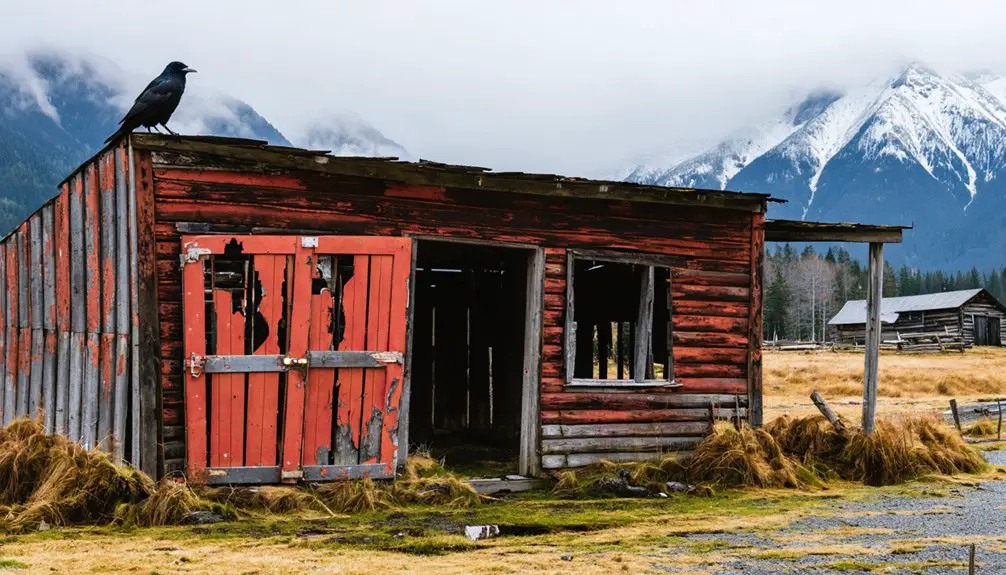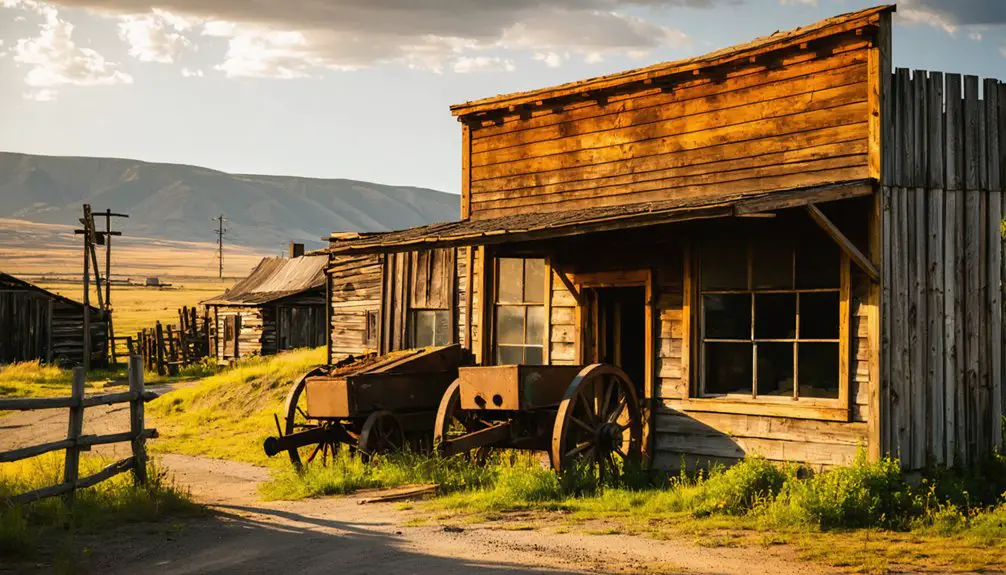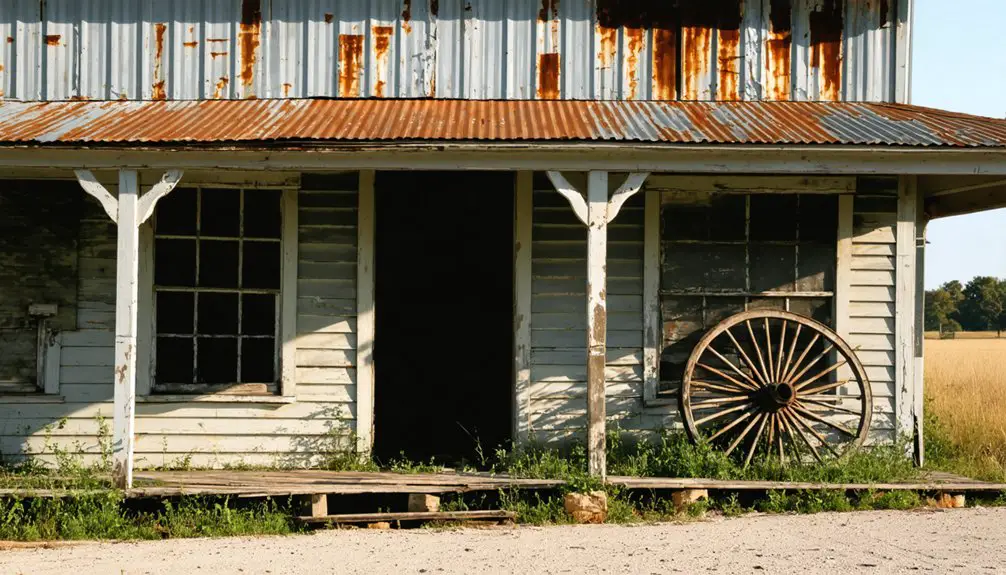You’ll find Buncom, Oregon’s best-preserved ghost town, at the intersection of Sterling Creek and Little Applegate Roads. Chinese miners first established this settlement in 1851, and it grew to 175 residents by 1896 after gold discoveries attracted more prospectors. Today, three historic structures remain: the post office, bunkhouse, and cookhouse, maintained by the Buncom Historical Society. Behind these weathered buildings lies a rich tapestry of frontier life, cultural diversity, and mining innovation.
Key Takeaways
- Buncom is a historic ghost town in Oregon, established in 1851 by Chinese miners and later developed into a thriving mining community.
- Only three historic structures remain today: the Post Office, bunkhouse, and cookhouse, preserved by the Buncom Historical Society since 1990.
- The town peaked in 1896 with 175 residents before declining after its post office closed in 1918 and a wildfire destroyed most buildings.
- Gold mining, along with cinnabar, chromite, and silver extraction, formed the economic backbone of historic Buncom’s development.
- Located 19 miles from Medford at Sterling Creek and Little Applegate Roads, Buncom showcases Oregon’s mining and frontier heritage.
From Mining Camp to Historical Legacy
While many Oregon ghost towns faded into obscurity, Buncom’s transformation from a modest mining camp to a significant community hub exemplifies the dynamic growth of frontier settlements in the American West.
Buncom stands as a testament to frontier resilience, rising from humble origins to become a vital center of Oregon’s mining community.
Located 19 miles from Medford, visitors can still view the historic site at the intersection of Sterling Creek and Little Applegate Roads.
You’ll find its origins in 1851 when Chinese miners first established their claims, though the discovery of gold by Sterling and Davis in 1854 sparked rapid expansion.
As mining techniques evolved, so did the settlement’s character – from a basic camp to a bustling crossroads complete with a general store, saloon, and post office. The area reached its peak when the population grew to 175 residents by 1896.
Without formal community governance, the Buncom Mining District regulated local affairs after 1867.
Today, just three twentieth-century buildings stand as silent witnesses to this once-thriving community that served local ranches and miners for over 60 years.
Early Chinese Settlement and the Gold Rush
You’ll find the origins of Buncom’s Chinese settlement in 1851, when miners first discovered gold deposits along Sterling Creek and established a bustling camp.
The mining community quickly grew to include a diverse population of Chinese laborers who worked abandoned claims using placer mining techniques, while also constructing essential infrastructure like the 5-mile China Ditch. Similar to the Auburn Ditch project in eastern Oregon, these water systems were crucial for mining operations.
Your understanding of early Buncom isn’t complete without recognizing how Chinese miners operated within a complex frontier economy alongside white settlers, Native peoples, and African American miners, contributing considerably to the area’s development during the height of the gold rush.
Mining practices evolved from simple methods as operations expanded, with miners transitioning from pans and shovels to more efficient hydraulic mining techniques.
First Chinese Gold Discovery
As news of the California Gold Rush reached China in 1848, thousands of Chinese men immigrated to mining regions across the American West, including southern Oregon’s Buncom area.
In 1851, gold was discovered near Sterling Creek, just four miles upstream from Little Applegate River, and Chinese miners quickly established themselves among the first settlers of the mining camp. Most miners were farmers from Taishan who sought better economic opportunities in America.
- Chinese miners specialized in working “picked over” claims that white miners had abandoned, developing innovative techniques for gold extraction from less profitable deposits.
- Under the leadership of mining bosses like Gin Lin, Chinese mining operations flourished despite Oregon’s exclusion laws.
- Chinese crews constructed extensive water management systems, including the five-mile China Ditch, demonstrating their expertise in hydraulic mining methods.
The settlement grew into a bustling supply center with a saloon and general store, serving the needs of the expanding mining community.
Mining Camp Cultural Diversity
During the early 1850s, Buncom’s mining camp emerged as a diverse cultural crossroads where Chinese, white American, and Indigenous peoples converged in pursuit of gold.
You’ll find that Chinese miners made up nearly half of Southwestern Oregon’s mining population by the 1860s, establishing distinct cultural practices while adapting to camp life.
Though they faced severe restrictions under Oregon’s exclusion laws, enterprising individuals like Gin Lin demonstrated remarkable success in acquiring and operating claims.
The camp’s cultural exchange wasn’t always peaceful – white miners often pushed Chinese workers to less desirable claims, while local Dakubetede people were violently displaced from their ancestral lands.
Despite these tensions, mining practices evolved through necessity and innovation, as Chinese miners developed techniques to work “played out” claims, contributing greatly to Buncom’s growth as an essential supply and distribution center.
Settlement Growth and Impact
While gold discoveries along Sterling Creek initially drew prospectors to the area, it was Chinese miners who established the first permanent settlement at Buncom in 1851. Their contributions helped shape the region through specialized mining techniques and infrastructure development, including the five-mile China Ditch that enabled hydraulic mining operations. Historical records show that Tree of Heaven plants were commonly found near these mining settlements.
You’ll find evidence of significant growth during Buncom’s peak years:
- The establishment of the Buncom Mining District in 1867 brought formal organization to mining activities.
- Early development included a general store and J.T. Williams’ saloon in 1861.
- The addition of a post office in 1896 marked the town’s maturation.
Beyond gold, the settlement’s economy diversified through the extraction of cinnabar, chromite, and silver, while Chinese miners’ expertise in reworking played-out claims helped sustain the town’s mining operations.
The Rise and Fall of a Frontier Community
When gold was discovered along Sterling Creek in 1851, Buncom emerged as a bustling mining camp at the confluence of Sterling Creek and the Little Applegate River in southwest Jackson County, Oregon.
You’ll find that community dynamics shifted dramatically as Chinese miners, who first established the camp, were soon outnumbered by miners from California and Oregon.
The town’s economic changes tell a classic frontier tale. After James Sterling and Aaron Davis’s major gold strike in 1854, Buncom flourished with a general store, livery stable, post office, and saloon serving the mining community.
Gold brought prosperity to Buncom, transforming a simple mining camp into a thriving frontier town with essential businesses.
Today, visitors can explore the historical mining town while appreciating scenic views of the Little Applegate River.
But as gold deposits dwindled, the town adapted to support surrounding ranches. By 1918, the closure of the post office marked Buncom’s final decline.
A subsequent wildfire destroyed most buildings, leaving only three structures as silent witnesses to this frontier community’s rise and fall.
Native American Heritage and Displacement

Before miners and settlers claimed Buncom’s land in the 1850s, the Athapaskan Dakubetede people maintained a permanent village at the mouth of Sterling Creek.
You’ll find their story reflects the broader pattern of indigenous resilience in the face of devastating displacement. When gold was discovered, miners flooded the area, leading to violent conflicts and the burning of Native villages during the Rogue River Wars. Euro-American colonists supported federal extermination policies that contributed to the widespread violence. Like many other tribes, the Dakubetede faced settlers who justified their actions through Manifest Destiny beliefs.
- Two-thirds of surviving Native people were forced onto reservations by 1857
- Despite treaties promising resources, many agreements were broken or never ratified
- Cultural preservation continues through descendant communities like the Confederated Tribes of Siletz Indians
The impact was severe – by the 1930s, few individuals still identified as Dakubetede, though their legacy lives on through oral histories and traditional knowledge passed down through generations.
Landmarks and Preserved Structures
When you visit Buncom today, you’ll find three main historic structures that have survived: the Post Office, a wooden bunkhouse, and an old cookhouse.
Two of these buildings were relocated from their original position two miles downstream to create the current preserved ghost town site.
While these structures primarily date from the early to mid-20th century rather than the gold rush era, they’re maintained by the Buncom Historical Society through stabilization efforts that preserve their authentic, weathered appearance.
Historic Remaining Buildings Today
The historic remnants of Buncom stand as a proof to Oregon’s mining era, with three preserved buildings marking the site of this once-bustling settlement.
Through dedicated preservation efforts, you’ll find a moss-covered post office with a tiny front porch, a weathered wooden bunkhouse with vertical planks, and a crooked cookhouse nestled among tall pines.
Two of these historic architecture examples were relocated from two miles downstream to create this reconstructed ghost town.
- The post office, established in 1896, features boarded windows and served as the town’s administrative hub until 1918.
- The bunkhouse displays a distinctive A-frame roof and provided shelter for miners and ranch workers.
- The cookhouse, situated at the base of a small hill, represents the town’s social gathering space.
Structural Preservation Over Time
Since its incorporation in 1990, Buncom Historical Society has spearheaded preservation efforts to protect the town’s three surviving structures from Oregon’s harsh elements and natural decay.
You’ll find the bunkhouse, cookhouse, and 1910 post office standing as proof of the town’s rich history, though a devastating wildfire destroyed most other original buildings around 1918.
The preservation challenges are significant, as these early 20th-century structures face continuous weathering in the forested Applegate Valley.
Two buildings were actually relocated from two miles downstream to guarantee their survival.
The society carefully maintains structural integrity while balancing authenticity with visitor safety, avoiding modern alterations that would compromise the site’s historical value.
They’ve implemented specific fire prevention protocols, learning from the area’s wildfire history.
Life in Buncom’s Golden Era

During Buncom’s golden era, life centered around a bustling mix of gold mining, logging, and ranching activities that defined this frontier settlement.
You’d have found yourself among miners, loggers, and ranchers who built a resilient community at the confluence of Sterling Creek and Little Applegate River. The town’s mining traditions shaped daily routines, with residents gathering at the saloon and general store to trade goods and stories.
- You could stock up on supplies at the general store, established in the 1860s
- You’d meet fellow settlers at the local saloon, a social hub since 1861
- You’d rely on the post office, opened in 1896, to stay connected with the outside world
This self-sufficient community embodied the independent spirit of Oregon’s frontier, where neighbors helped neighbors survive and thrive.
Frequently Asked Questions
Are There Any Reported Ghost Sightings or Paranormal Activities in Buncom?
Ever wonder about ghostly encounters in a true ghost town? You won’t find documented paranormal investigations or confirmed sightings here – just haunting memories lingering in weathered buildings amid towering pines.
What Happened to the Chinese Miners Who First Discovered Gold There?
After their 1851 gold discovery, you’d find most Chinese miners were pushed out by white prospectors, discriminatory laws, and natural disasters, while others adapted under leaders like Gin Lin until the 1870s.
Can Visitors Enter and Explore the Remaining Buildings Today?
You can’t enter the buildings directly, but you’re free to view them from outside. Visitor guidelines encourage respectful observation of these fragile structures while the Historical Society maintains them for preservation.
How Many People Lived in Buncom During Its Peak Population?
You won’t find exact population records in Buncom’s history, but like other gold mining camps of that era, it likely peaked at somewhere between several dozen to a few hundred residents.
Was There Ever a School or Church Established in Buncom?
Ever wonder about Buncom’s community life? Based on historical records, you won’t find evidence of any established schools or churches there. The town’s brief mining camp history didn’t support permanent institutions.
References
- https://www.oregonencyclopedia.org/articles/buncom/
- https://applegater.org/pdf/2023/v16n03/v16n03p21.pdf
- https://www.culturaltrust.org/get-involved/nonprofits/buncom-historical-society/
- https://southernoregongrapevine.com/buncom-historic-ghost-town-in-jackson-county-oregon/
- https://markers.sohs.org/node/112
- https://www.roy-stevenson.com/ghost-towns-oregon.html
- http://www.photographoregon.com/Buncom-Oregon.html
- http://ochalp.blogspot.com/2014/08/
- http://ochalp.blogspot.com/2014/08/jackson-county.html
- https://visitgrantspass.com/blog/explore-the-rich-mining-history-of-southern-oregon/



